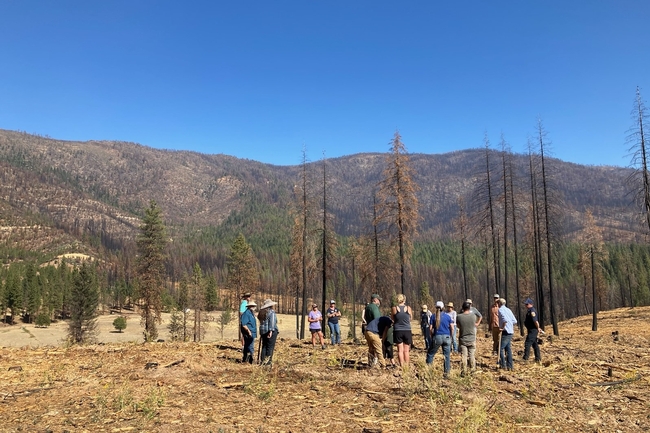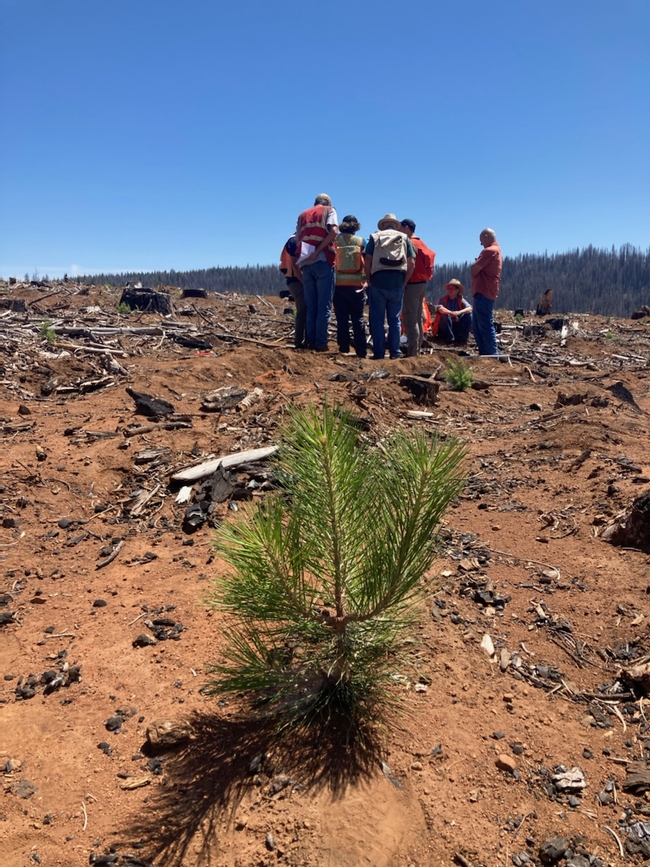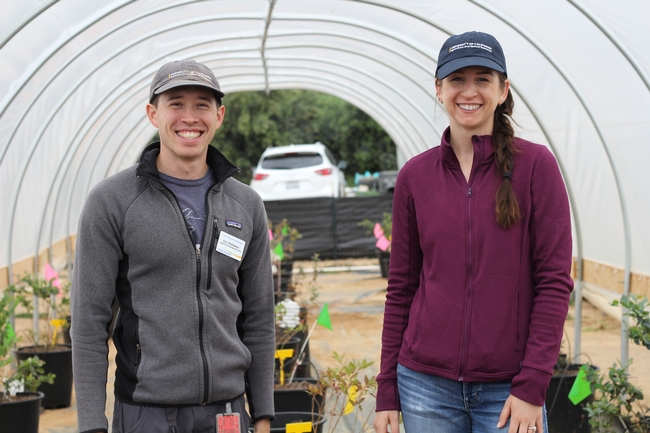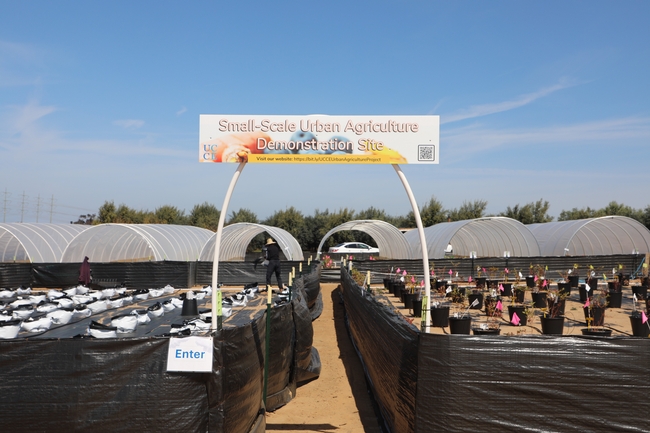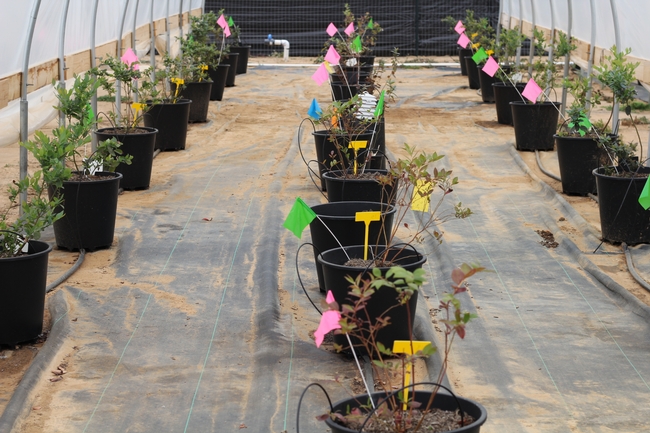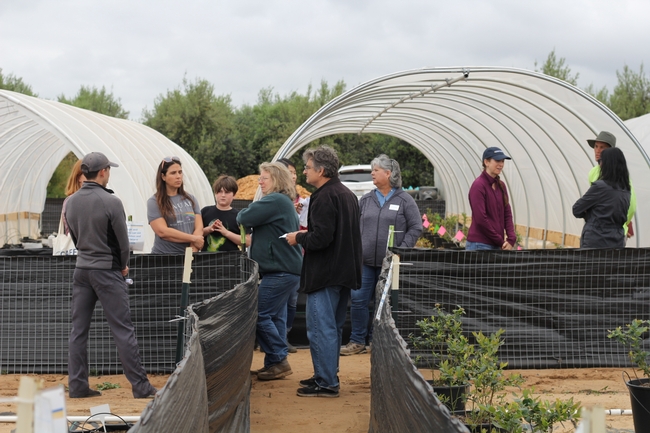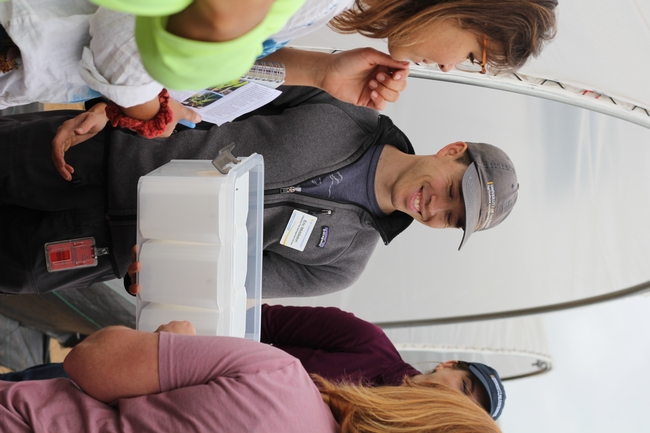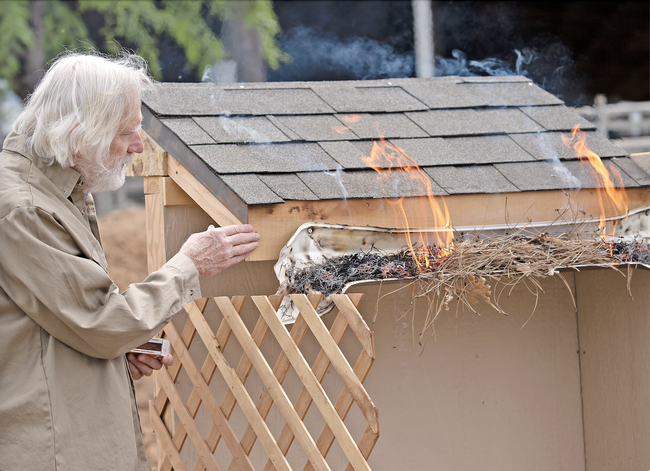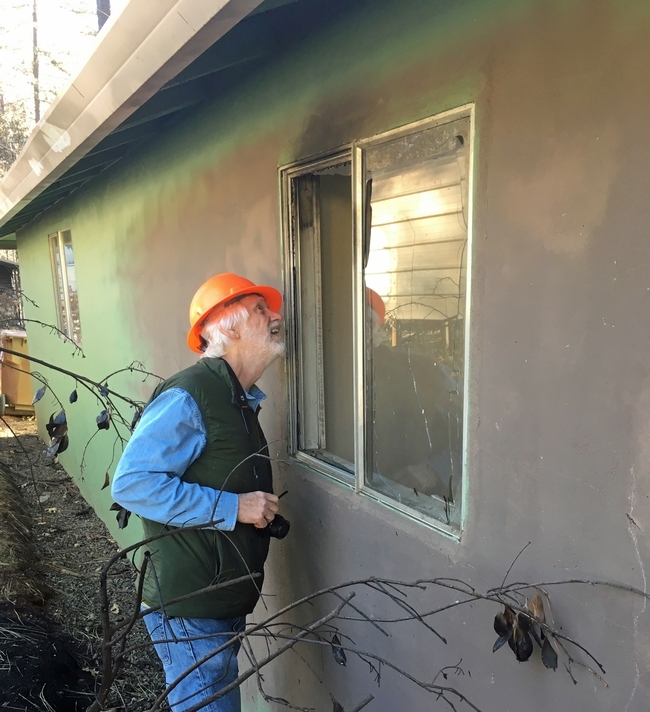News stories
UCCE report: Local forest restoration teams effective at rapid response
Quickly planting trees after wildfires crucial for communities, ecosystems, carbon goals
As the climate crisis fuels more high-severity wildfires, many forests – adapted to bounce back from frequent but less-intense fires – are struggling to recover quickly.
“In a lot of locations, forests in the Sierra Nevada that burn at high severity are not regenerating on their own,” said Susie Kocher, University of California Cooperative Extension forestry and natural resources advisor for the Central Sierra. “They need to have living trees to drop seeds; if everything dies in an intense fire, then there's a high likelihood in those locations that trees might not return for a while.”
According to Kocher, a forest may take multiple decades to grow back on its own, seeding in very slowly from the edges of a burn. To speed up that regeneration process, a pilot program of local “Emergency Forest Restoration Teams,” or EFRTs, have been helping forest landowners rapidly remove dead trees, plant new seedlings and expedite other vital tasks after wildfires.
Kocher is a co-author of a recently released report evaluating the EFRTs, which appear to be effective in assisting often-overwhelmed private landowners navigate competitive funding programs and complicated permitting pathways after wildfire. Small private landowners in California own 7 million acres, comprising 22% of forested land across the state.
“None of our current assistance programs were really designed to rapidly respond to high-severity fire disasters,” Kocher said. “And we're just getting so much more high-severity fire now that there needed to be a different way of helping people, besides business as usual.”
Lead agencies improve coordination of restoration efforts
Drawing from a successful model in Washington, Kocher and other members of the Governor's Forest Management Task Force recommended the formation of EFRTs in 2019 and this recommendation made it into the California Wildfire and Forest Resilience Action Plan of 2021.
Following the Caldor, Dixie and Tamarack fires during that year, disaster relief funds from CAL FIRE and the U.S. Forest Service enabled the establishment of pilot EFRTs in each of the affected regions. A key innovation was designating a local lead agency to coordinate restoration efforts: the El Dorado Resource Conservation District (Caldor), the Feather River Resource Conservation District (Dixie) and Alpine County (Tamarack).
“The idea is that one well-established local agency gets the funds to carry out all the reforestation work,” Kocher said. “They find contractors for the landowners and plan and carry out all the work needed, including dead tree removal, site preparation and replanting; this helps it be more coordinated across the landscape and reduces competition for contractors.”
“Also, for most of that work, there's no cost to the landowner – which is a huge benefit to them, because these things can get really expensive, like many thousands of dollars an acre,” Kocher added.
Although there was an initial steep learning curve for the local lead agencies on the complexities of reforestation and the maze of required permits, they quickly executed a significant number of forest restoration treatments. Within two years, the three pilot teams had collectively completed over 2,500 acres of dead tree removal and 1,400 acres of conifer planting.
“The overwhelming benefit of the pilots was that a lot of work got done on the ground, that otherwise would not have been done – at least not in the timeframe that was made possible by the EFRTs,” said Daylin Wade, a UCCE staff research associate and co-author of the recent report, who synthesized feedback from interviews of professionals involved in the program.
Rapid reforestation better financially, ecologically
Both Wade and Kocher underscored how the EFRTs were crucial in completing restoration tasks in a timely manner. Removal of dead wood becomes trickier and more expensive over time, as the trees decay and are dangerous to cut down.
“A major accomplishment was getting trees out of there while it was both safe and economically viable to remove those trees – and getting trees in the ground before shrubs dominate the site,” Wade explained.
It's also imperative to quickly remove the dead trees to reduce the fuel load and minimize the chances of re-burn in the area.
“If you're not doing this work, then you're actually endangering the investment that you're putting into rebuilding communities that burned, because they're in danger of burning again if you have huge piles of dead trees everywhere,” Kocher said.
Furthermore, expediting those tasks helps restore the forest cover that is crucial for sequestering carbon and achieving the goals of California's sweeping climate action plan – such as attaining carbon neutrality by 2045.
“We have very ambitious carbon goals for our forests in California, and so reestablishing them – even on private lands – is a public benefit,” Kocher said.
Evaluation of EFRTs by UC Cooperative Extension continues
In addition to enumerating the progress of the three EFRT case studies, the evaluation report also lists recommendations to further enhance the program, such as securing rapid and flexible funding for future EFRTs, improving guidance for local lead agencies and streamlining permitting processes.
The authors also stressed the need to expand opportunities for the commercial sale of woody material in the aftermath of a wildfire event. Selling logs and wood chips reduces the volume of material that would need to processed onsite by the EFRTs and their contractors, thereby defraying some of the costs for that work.
But there simply hasn't been a sufficient market for that woody biomass.
“It's a big barrier,” Kocher said. “If we had a healthier timber market, it would be easier to make this stuff pay its own way and be less of a subsidized endeavor.”
UC Cooperative Extension's EFRT evaluation work – made possible by funding from the U.S. Forest Service State, Private and Tribal Forestry, Region 5 – will continue for the next couple years. On the heels of this first report, Wade will next gather and summarize feedback from private landowners on whether the EFRTs are meeting their goals.
And, later this summer and fall, researchers will begin assessing the ecological success of the plantings in the restoration areas, surveying seedling survival and gauging the volume of competing vegetation.
“It's hugely encouraging that we've gotten all these trees in the ground, but it's not the end of the process – it's just the beginning,” Kocher said. “Trees and forests need to be maintained over time, so this next step will let us see how successful that has been, and if there are additional steps needed to actually ensure that these trees succeed and thrive.”
The full report, dedicated to the memory of report co-author and UCCE advisor Ryan Tompkins, can be found at https://ucanr.edu/efrt.
Could empty lots be growing food, economic opportunity?
UCCE scientists study feasibility of specialty crops for small urban growers
The vacant lots around your neighborhood could be growing fruits and vegetables and making local produce more accessible – while reducing energy needed to transport and distribute the food. Could turning those empty lots into small farms also become opportunities for economic development?
To answer this question, a team of researchers from University of California Cooperative Extension in San Diego County are investigating the economic feasibility of growing high-value specialty crops in urban settings like vacant lots. The project – led by Eric Middleton, UCCE integrated pest management advisor for San Diego, Orange and Los Angeles counties – is currently in progress at The Flower Fields in Carlsbad, a seasonal attraction for locals and tourists.
Tucked away in the back of the field is the Small-Scale Urban Ag Demonstration Site where Middleton and his team established a small farm on approximately 17,000 square feet, starting fall 2023. Funded by the U.S. Department of Agriculture National Institute of Food and Agriculture, the farm is designed to evaluate containerized production both outdoors and under high tunnels.
Growers don't necessarily need land, just space
High tunnels, also referred to as hoop houses, are semi-permanent structures that act similarly to greenhouses in providing a controlled environment. For the experiment, Middleton will compare cost, effort and durability of two types of high tunnels: one made of steel and the other out of PVC pipes.
“We want to give interested growers information on as many options as we can,” said Middleton, who explained that the project is motivated by the challenges of urban settings, including limited space and lack of arable land.
In the trial, they are growing turmeric, ginger and blueberries. The high-value crops were selected because of their potential to earn a profit. Data evaluating plant variety, soil mix, fertilizer, growth performance, yield and pest and disease pressures will be collected and reported when the project concludes in 2026.
As the crops develop in containers – blueberries in pots and turmeric and ginger in grow bags – Middleton pointed out the mobility aspect of the study, noting that growers don't necessarily need land, just space.
Whether it's a backyard or a rooftop, containerized production means easier transport, especially since vacant land doesn't always remain vacant forever and urban lots may often need soil remediation. Growing in containers solves the anticipated problem of having to relocate.
Where to set up shop in San Diego County
Jan Gonzales, project coordinator and community education supervisor for UCCE San Diego County, is leading the effort to identify available urban land in San Diego County as well as the policies and procedures for growers to access these spaces.
Gonzales is collaborating with community members who are working on similar projects to identify space for prospective growers.
“This has been done before for different objectives and for specific areas in the region, but the information was either project-specific and not publicly available, or not easy to find,” Gonzales said.
Having spoken with people associated with previous or ongoing agricultural land mapping projects, Gonzales has agreed to coordinate and facilitate an advisory work group to discuss areas of potential collaboration and develop project efficiencies. She anticipates holding the first group meeting before the end of the summer.
A production guide to help community members re-create the project
The ideal audience for a study like this is anyone who wants to grow specialty crops, according to Lindsey Pedroncelli, interim director of UC South Coast Research and Extension Center in Irvine, who worked on the project alongside Middleton when she was a staff research associate with UCCE San Diego.
“If you're a new grower or a grower who wants to diversify your crop production, what we're learning here can be applied to you,” said Pedroncelli.
Pedroncelli has been instrumental in bringing the experiment to life and documenting its step-by-step workflow thus far. The production guide, which is being created as the study unfolds, will include instructions detailing how to replicate the experiment from the ground up. Currently, it contains information on how to design your farm, the materials to buy, building structures, irrigation setup and crop management.
The most intriguing open question, whether the operation is profitable, is the driving force behind the production guide and will certainly be addressed, Pedroncelli said.
Book a tour and visit the farm
When visiting the farm, you'll encounter three varieties of blueberries: Star, Snowchaser and Misty. Snowchaser has been a top producer since it was planted in January, but the variety is known to be an early season producer.
Using only one variety of each, the turmeric and ginger were planted in late March-early April. With some unanticipated cold weather in San Diego County, both crops struggled when transitioning out of dormancy, leading to very slow progress, which the team is still navigating today.
Visually, Middleton and his team have noticed differences between the crops growing under the high tunnels versus those grown outdoors, although the data has not been analyzed to confirm or explain notable differences.
Attempting to demonstrate how to profitably grow high-value crops in urban settings using limited space and resources, Pedroncelli said she hopes this study will also encourage people to grow culturally significant crops for their communities.
To tour the Small-Scale Urban Ag Demonstration Site at The Flower Fields in Carlsbad, email Eric Middleton at egmiddleton@ucanr.edu with "Urban Agriculture Demonstration Site Tour" in the subject line.
To learn more about the project and its progress, visit https://ucanr.edu/sites/socalIPM/Small_Scale_Urban_Agriculture_Project_/.
ANR hires expertise in urban pests, plants and small farms
From Siskiyou County through Riverside County, University of California Agriculture and Natural Resources has hired UC Cooperative Extension experts to help Californians address challenging issues.
The eight recently hired UC Cooperative Extension specialists, advisors and coordinators bring expertise in urban pest management, healthy families, regenerative agriculture, plant science, small farms and food safety to their communities.
Since 1914, UC Cooperative Extension researchers have been working directly with community members to improve their lives and livelihoods.
To see a list of UC Cooperative Extension experts who have joined in the past few months, visit https://ucanr.edu/About/DirectorySearch/Recent_Hires. The most recently hired scientists are introduced below.
Lee brings expertise in urban pest behavior to Capitol Corridor IPM role
Sang-Bin Lee joined UC ANR as the urban integrated pest management advisor for the Capitol Corridor – comprising Sacramento, Yolo and Solano counties – to help communities manage urban pests such as cockroaches, termites and ants.
“My high-level hope is to improve public health and the well-being of people in the Capitol Corridor region by implementing and improving the IPM program,” Lee said.
A native of South Korea, Lee earned his bachelor's in biology from Pusan National University. After working in the food manufacturing sector (which included a stint in Brazil, where he learned basic Portuguese), Lee decided to pursue his passion for studying animal behaviors. During his master's program in ecology at Pusan National University, Lee investigated behavioral changes in zebrafish after pathogen infection.
“My goal was to detect fish with symptoms much earlier than conventional methods to prevent the spread of pathogens in fish farms,” he said.
Intrigued by research on social insects, Lee went on to earn a Ph.D. in entomology from the University of Florida, where he studied the social behaviors of termites. Lee has published 34 peer-reviewed articles in professional journals and has received several awards from Entomological Society of America and other professional societies.
He said that he finds urban pest management to be a fascinating discipline – and a very rewarding endeavor – in the field of entomology.
“My interests lie in the behavior of urban pests, and studying their behavior often provides a great opportunity to improve control measures,” Lee explained. “I have had many opportunities to communicate with people from the pest control industry and homeowners; conversations with these people often inspire me to work harder to help those who need my assistance.”
Lee is based in Fairfield, at the UC Cooperative Extension office in Solano County, and can be reached at sablee@ucanr.edu and (530) 574-9835. He is on X/Twitter @SangBinLee4.
New farm advisor Singh to bring latest research to Siskiyou County
Jagdeep Singh recently joined UC ANR as the agronomy advisor for Siskiyou County. In this capacity, Singh will primarily focus on crop production in alfalfa, pasture and small grains, as well as pest control and water management.
Originally from Punjab, India's agriculture-rich state, Singh brings a unique perspective to his work.
“My passion lies in directly impacting the lives of farmers who feed the world,” he said. “I'm driven by a constant thirst for knowledge and a commitment to bridging the gap between the most up-to-date research and practical, on-farm solutions. What motivates me is understanding farmers' needs and providing science-based answers to their questions.”
Singh earned a B.S. from Punjab Agricultural University, an M.S. from New Mexico State University, and a Ph.D. from Auburn University.
During his Ph.D. studies, he assessed 70 years of cotton breeding impacts on yield, nutrient relations and root architecture, while also studying cover crops for soil health improvement. His M.S. work focused on guar, evaluating its growth, yield, water extraction patterns and water use efficiency under deficit irrigation, as well as identifying cold-tolerant germplasm for cooler regions of the Southern High Plains.
In his new role at UC ANR, Singh aims to build strong relationships with the local community, certified crop advisers and industry groups, leveraging the well-established extension system.
Singh can be reached by email at fgssingh@ucanr.edu or by calling the UCCE Siskiyou office at (530) 842-2711.
Rosenberg joins UCCE as regenerative agriculture farm advisor
Sara Rosenberg joined UCCE as a regenerative agriculture farm advisor for Mariposa, Merced and Stanislaus counties.
Her disciplinary focuses are agroecology, sustainable nutrient management, and extension research and methodology. Her past research centers on understanding the implications of diversification (with a focus on crop rotations and cover crops) for California rice systems. For her master's program thesis, she conducted a countywide assessment to learn from rice growers about their experiences with crop rotations and understand barriers to adoption, opportunities, and required resources for successful implementation. This two-year study engaged grower communities to help develop research goals for her Ph.D. studies.
Her doctoral research explored how different summer crop rotations affect multiple sustainability factors including soil health, crop yields, weeds, input use and economics. She also assessed different cover-crop species performance in rice environments and their carbon and nitrogen contributions.
She earned a master's in international agriculture development and a Ph.D. in horticulture and agronomy from UC Davis.
Prior to working on her Ph.D., Rosenberg was an agriculture advisor in the Peace Corps for more than three years. She worked closely with smallholder farmers in West Africa, implementing conservation agriculture programs and increasing agricultural resilience in both annual crops and tree crops, mainly in the cashew forestry sector. In California, she has worked on farms for more than eight years, including running her own small, diversified farm in Woodland.
She is passionate about community-led development and using participatory research as a powerful tool for developing sustainable solutions. Her aim is to develop collaborative programming that will support a wide range of farm types, including commercial and small-scale, organic and conventional, annual crops, tree and vine crops, and livestock production systems.
She is developing a robust research program aimed at assessing farm sustainability impact across ecological, agronomic, social and economic factors. She will be collaborating with farmers to help overcome barriers to adopting regenerative practices and build their capacity to advance sustainability goals. Rosenberg also will be developing and promoting tested integrative management practices that increase climate resilience and ecosystem sustainability across diverse farming environments.
Rosenberg is based in Mariposa and can be reached at srosenberg@ucanr.edu and (209) 966-2417 ext. 1417.
Sangha joins UCCE as community water systems advisor
Laljeet Sangha joined UCCE as a community water systems advisor for Kern, Tulare and Kings counties.
To enhance community resilience, Sangha will lead an integrated extension education and applied research program in water resource management and community development.
He will address critical questions regarding the impacts of environmental stressors, such as chronic long-term droughts, water contamination and increased groundwater demand. Additionally, he will assist in water system consolidations and help communities meet regulatory goals such as those set by the Sustainable Groundwater Management Act (SGMA) and the Irrigated Lands Regulatory Program (ILRP).
Originally from Punjab, India, Sangha earned his undergraduate degree in agricultural engineering from Punjab Agricultural University. He received his M.S. in biosystems engineering from Auburn University and his Ph.D. in biological systems engineering at Virginia Tech.
Sangha's early research focused on the influence of climate variability on ecologically sustainable water withdrawals from streams for irrigation. For his doctoral studies, he evaluated the impact of permit exemptions, climate change and demand growth on water supply. Additionally, he developed methods to quantify unreported water use for crop irrigation.
Sangha also has collaborated on projects in the Colorado River Basin, which explore why the Colorado River no longer reaches the sea. His work includes evaluating the effects of limited water availability on irrigation operations and developing adaptive options for farming communities in the basin.
Sangha is based in Bakersfield and can be reached at lsangha@ucanr.edu.
Beveridge joins ANR's Small Farms team
Claire Beveridge joined UC ANR as a small farms water-conservation academic coordinator for Fresno, Tulare and Madera counties. She is also part of the statewide UC Sustainable Agriculture Research and Education Program, or SAREP.
As an academic coordinator, Beveridge supports small-scale, diversified and socially disadvantaged farmers in Fresno and surrounding areas in on-farm water conservation through education, technical assistance, outreach and research activities. This encompasses aiding farmers with improved irrigation practices and technologies, groundwater regulation compliance and on-farm groundwater recharge.
She also facilitates small-scale farmer access to state incentives for water and energy efficiency, as well as drought and flood relief programs. Beveridge also helps to inform state water policy on the unique needs of small-scale farms.
She is broadly interested in fostering sustainable water resource management through interdisciplinary and collaborative approaches among communities, decisionmakers and researchers.
Beveridge holds a Ph.D. in civil and environmental engineering with an emphasis in hydrology from the University of Washington. She conducted postdoctoral research at Florida International University and earned her bachelor's degree in civil and environmental engineering from UC Berkeley. She is a licensed Professional Civil Engineer in California, an inaugural editor of the Community Science Exchange journal and resource hub, and recently completed a USDA International Agriculture Education Fellowship in Uganda.
“I grew up in Madera and am excited to be serving my home region as part of UC ANR,” she said.
Beveridge is based in Fresno and can be reached at cbeveridge@ucanr.edu.
Pourkhalili to promote healthy families and communities
Azin Pourkhalili joined UCCE as a youth, family and community advisor for Kern, Inyo and Mono counties.
In her role, she will promote healthy families and communities by designing, delivering and evaluating strategies for encouraging nutrition and physical activity in youth and their families. Additionally, she will provide academic oversight of community education and outreach program staff who work with families and youth, including the UC 4-H Youth Development Program, CalFresh Healthy Living UC Nutrition Education Program, Expanded Food Nutrition Education Program (EFNEP) and Juntos.
Pourkhalili brings over six years of experience in conducting health intervention research programs, including their development, implementation and evaluation.
Before moving to California, Pourkhalili was a Virginia Cooperative Extension research scientist. She worked on multiple health intervention projects, including nutrition education for older adults through the Elder Nutrition and Food Safety program and the prevention and management of chronic diseases through programs such as the Lifestyle Change Program, Diabetes Prevention Program, Balance Living with Diabetes, and Kick'n Cancer. She also collaborated with the Virginia Department of Health on various projects.
Pourkhalili's academic background encompasses the latest research in nutrition and physical activity education programs, chronic disease prevention programs and health education programs for different age groups. Building on her experience in implementing and evaluating nutrition education programs, her future research aims to address the unique health education needs of diverse communities in California. She plans to continue researching the evaluation and effectiveness of health education programs, such as CalFresh Healthy Living UC, EFNEP and 4-H.
She holds a Ph.D. in human nutrition, food and exercise, specializing in community and behavioral science, and a graduate certificate in gerontology from Virginia Tech.
Pourkhalili is based in Bakersfield and can be reached at apourkhalili@ucanr.edu.
Atume to provide small farms SGMA technical assistance
Ngodoo Atume joined UC ANR as a Sustainable Groundwater Management Act small farms technical assistance coordinator in the Sustainable Agriculture Research and Education Program.
She will provide technical information, services, policy analysis and recommendations needed to engage and protect small-scale farmers in the implementation of the Sustainable Groundwater Management Act (SGMA).
Before joining UC ANR, Atume worked as a water policy analyst advocating for the implementation of the Human Right to Water in California. She also worked on the inclusion of underrepresented stakeholders in SGMA, Central Valley Salinity Alternative Long-Term Sustainability (CV-SALTS) and the Irrigated Lands Regulatory Program (ILRP).
Born and raised in Nigeria, Atume earned her bachelor's degree in water resources and environmental engineering at Ahmadu Bello University, where her research focused on the treatment and reuse of wastewater. She has a master's degree in sustainable water management from Tufts University.
Atume is based at the UC ANR office in Davis and can be reached at natume@ucanr.edu.
Fujiyoshi joins Capitol Corridor small farms team
Phillip Fujiyoshi joined UCCE small farms team in the Capitol Corridor as an extension and research associate. Working with Margaret Lloyd, UCCE small farms advisor, Fujiyoshi supports underserved farmers in Yolo, Sacramento and Solano counties by providing them with financial and agronomic technical assistance and making extension materials available in Spanish.
Born and raised in Santa Maria, Fujiyoshi earned his bachelor's degree in biology at the Massachusetts Institute of Technology. His academic knowledge of Spanish transformed into bilingual proficiency thanks to his life experiences of living with Spanish roommates, participating in a tree-planting brigade in Nicaragua and setting up a Spanish-speaking household with a Nicaraguan partner. The Nicaragua trip also sparked his lasting interest in agriculture, leading him into doctoral studies in agroecology at UC Santa Cruz.
After completing his Ph.D., Fujiyoshi performed molecular assays, contributed to phylogenetic studies, and led a spore-trapping field study in a lab studying grapevine trunk diseases. In addition, he pursued outside interests in agriculture, including winning an individual grant to study cabbage aphid behavior, pursuing informal cover crop trials in a community garden plot, volunteering on the UC Davis Student Farm, and giving agronomic advice to growers at the farmers market.
Fujiyoshi is based in Woodland and can be reached at (530) 666-8143 and pfujiyoshi@ucanr.edu.
Report: Making homes more resistant to wildfire can be affordable
Priorities include removing objects within five feet of a house, upgrading vents
Wildfire losses cost taxpayers and communities hundreds of billions of dollars each year, and preparing communities before a disaster occurs is the best way to avoid damage to homes and neighborhoods. Retrofitting existing homes can make communities safer while avoiding billions in disaster costs.
As Californians learn to live with wildfire, scientists encourage improving the structure and design of houses and other buildings to help them survive wildfire. A new report shows that even inexpensive changes can increase wildfire resistance.
“Retrofitting a Home for Wildfire Resistance” suggests that some of the most effective strategies to reduce the vulnerability of homes and neighborhoods to wildfire can be done affordably.
“This report is a practical tool that helps evaluate the relative costs and benefits of fire-hardening retrofits,” said Yana Valachovic, a University of California Cooperative Extension forest advisor, who reviewed the study. “These retrofits can substantially improve the odds that a home or building will withstand wildfire exposures to embers, radiant heat or flame contact.”
The report is co-authored by Kimiko Barrett, wildfire research and policy analyst for Headwaters Economics, a non-partisan research organization based in Bozeman, Montana, and Stephen L. Quarles, UC Cooperative Extension advisor emeritus, who has studied the vulnerability of the built environment to wildfire exposures and potential mitigation strategies.
In partnership with California's Department of Forestry and Fire Protection, or CAL FIRE, Barrett and Quarles examined the costs for improving the structure and design of existing homes to increase their wildfire resistance.
“This tool can also help homeowners build a budget and prioritize tasks that often feel overwhelming,” Valachovic said. “Everyone should prioritize removing combustible vegetation, mulch, and stored materials within the first five feet of a structure and upgrading vents to resist embers.”
Simple actions can reduce a home's vulnerability to wildfire
The report's conclusions are derived from a detailed examination of the latest available science on mitigation strategies and construction costs. The authors identified costs for retrofitting structures to meet and exceed California's building code (Chapter 7A) for wildfire resistance, but the general principles and conclusions can be applied in other states, adjusting for local economic and supply conditions.
For a typical 2,000-square-foot home in California, retrofitting costs can range from $2,000 to upwards of $100,000 for the highest level of protection.
“When we looked at the latest building techniques and cost data, we found some effective retrofitting strategies can be done for between $2,000 to $10,000,” said Barrett. “While the highest level of protection can cost more, it is often not necessary. Simple actions such as removing flammable materials from near the home and removing debris from the roof can be done at little to no cost.”
The authors also incorporated effective mitigation strategies that could reduce risk without requiring costly upgrades over the entire home, such as replacing siding only on the side of a home that is close to another building, such as neighbor's home or a detached garage, or replacing combustible deck boards next to the home with a noncombustible deck board or metal grate.
They also incorporated a systems approach, where the vulnerability of adjacent components are considered, and recommend steps such as placing noncombustible surfaces at the intersection between two components.
For example, Quarles said: “Adding a gutter cover and ensuring the adjacent edge of roof is not vulnerable by incorporating a metal drip edge and, if necessary, a noncombustible bird stop at the edge of the roof. Or, replacing a combustible deck board next to the house and, if necessary, adding metal flashing at the base of the exterior wall.”
Cost estimates in the report include those for upgrading a home's exterior walls, roof, deck, windows, doors, eaves, gutters and near-home landscaping – all areas likely to be exposed to embers, direct flames and radiant heat.
“The graphics detailing specific elements of the retrofitting process are very useful,” Valachovic said.
Charts, architectural renderings and a detailed appendix of cost estimates provide a basis for a general understanding of the methods and budgets that homeowners might consider when retrofitting their home for wildfire resistance.
Retrofitting for wildfire can make communities safer
Contractors and others seeking information about building wildfire-resistant homes can gain valuable insights from this analysis, along with retrofit costs generated by the California Wildfire Mitigation Program.
“This analysis demonstrates that investing in wildfire-resistant retrofitting for homes is a cost-effective strategy to protect communities that could save billions in disaster costs,” said Barrett. “As more people live in fire-prone areas, we must also take a closer look at retrofitting homes to be stronger and more durable.”
While the authors hope Californians use the information to protect their homes, people who work in construction, development, design and policy also can use the information to show that retrofitting homes for wildfire resistance is an effective way to protect communities.
This 58-page report received funding from CAL FIRE and the U.S. Forest Service and can be downloaded for free at https://headwaterseconomics.org/wp-content/uploads/2024/06/Wildfire_Retrofit_Report_20240624.pdf.
Barnes brings hometown knowledge to UCCE in Lake, Mendocino counties
New Cooperative Extension director has worked extensively with Native American communities, youth groups
Growing up in Upper Lake, along the “North Shore” of Clear Lake, Matthew Barnes lived near several of the Lake County region's seven federally recognized tribes. Although he counted several Native Americans among his diverse circle of childhood friends, and was very familiar with those communities, Barnes was nonetheless quite nervous when he was appointed in 2009 as the inaugural executive director of the Boys & Girls Club of the Pomo Nation.
Barnes – a non-Native of European and Filipino descent – vividly remembers the tribal administrator paying him a visit on one of his first days on the job. “He said, ‘Hey, you have two ears and one mouth, so listen twice as much as you speak and you'll be fine,'” Barnes recalled. “And that's definitely stuck with me.”
That approach is continuing to guide Barnes in his new role as University of California Cooperative Extension director for Lake and Mendocino counties. He will guide and support research, outreach and education activities to meet the area's agriculture, natural resources, and youth and community development needs.
Since starting in May, Barnes has been getting a crash course from UCCE advisors and staff on viticulture research, pest management practices, 4-H camps, and a host of other projects and programs – while also meeting with local communities on the region's most pressing challenges.
“What I've been doing – and will continue to do – is just to listen and learn, and when I can add value to a conversation or project, then I'll do that,” Barnes said. “But leadership to me starts with the relationships we build – with our staff and with the community.”
Bringing a range of experiences in youth programs, social services
One area in which Barnes will certainly add value is developing youth and community programs. During his time with Boys & Girls Club of the Pomo Nation, it was one of only three Boys & Girls Clubs established on tribal land in California. In that role, Barnes faced the unique challenge of integrating the Boys & Girls Club curriculum into a community for which it was not originally designed.
By adapting the curriculum to include culturally relevant topics, Barnes transformed the program into a model that eventually aided in the creation of a Native American-focused branch, Boys & Girls Clubs of America Native Services.
“This initiative now serves as a national standard for Boys & Girls Clubs on tribal lands,” Barnes said.
He later became a director of California Tribal TANF (Temporary Assistance for Needy Families), a direct cash assistance and supportive services program for Native American families in 17 counties across the state.
During his decade of TANF work, Barnes launched career development programs, alcohol and other drug counseling programs, and cultural revitalization initiatives. Some of the programs are still running and serving communities to this day.
“The trick is making those programs something that participants can see the value in,” Barnes explained. “And to do that, you go into the communities and talk to people and listen to what they need – instead of you telling them what they need.”
Barnes' experience partnering with Native American communities is just one of the many strengths he will bring to UCCE and UC Agriculture and Natural Resources.
“We're very excited to have Matthew join the UC ANR family,” said Lynn Schmitt-McQuitty, UC ANR's director of County Cooperative Extension. “His personal knowledge of Lake and Mendocino counties and his previous work with Indigenous populations will be a tremendous asset to extending and elevating our work.”
Immediately prior to joining UC ANR, Barnes served as director of Lake County's Upward Bound program, which helps students from three local high schools experience and prepare for higher education.
“Overall, what drives me personally is the opportunity to make an impact on communities, on youth, and on people in general through program development and management,” Barnes said.
Inspiring young people as a mentor
Barnes' passion for youth development – and the impetus for his bachelor's degree in social work from Cal Poly Humboldt – can be traced to his AmeriCorps experience while he was attending Mendocino College. For two years, he worked as a tutor for young people, in Lake County and then in Sonoma County, and saw firsthand the difference educators and mentors can make in their lives.
“You could say I kind of caught the bug – just seeing the light bulbs go on when you're helping a youth of that age,” Barnes said.
From there, Barnes took a position directing teen programs for the Boys and Girls Club of Healdsburg, where he began to fully appreciate the importance of trusted adults simply “being there” for young people as a listening ear for whatever they want to talk about.
Among the many teens Barnes worked with, “Rodrigo” was a middle schooler who was pegged by his school and community as someone who could “slip through the cracks.” Rodrigo was the last to go home at the end of each day, and Barnes would chat with him – answering his questions about life or just talking about a new rap album.
“I realized I was ‘that person' for him – that person outside his house, outside his school,” Barnes said.
Even after Barnes left the Boys and Girls Club, Rodrigo – bound for university – invited him to his high school graduation. Barnes said it is tremendously gratifying to know he had a “small role” in shaping the path for Rodrigo – and countless others.
“Their success is still theirs; it's not necessarily because of me,” Barnes added. “My job is to do what I can in the moment to hopefully plant some seeds that may sprout in the future.”
Settled in Middletown, not far from his hometown, where he and his wife are raising two children, Barnes is now positioned to help nurture a flourishing Lake County and resilient Mendocino County.
“I feel like my past experiences, both in life and my career, have prepared me for this,” Barnes said.

